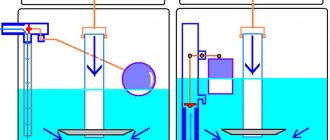Quite often, after flushing, a terribly unpleasant noise begins to be heard in the toilet, the toilet tank is humming, as if a waterfall or something like that has formed there.
The culprit is a faulty drain tank. Fortunately, this problem is minor and can be easily fixed. But before we talk about fixing this problem, let’s turn to the “filling” of the drain tank.
So that you understand what you are dealing with and can easily solve other problems, such as constantly running water into the toilet or stopping the tank from filling.
Other interesting questions and answers
What's the best way to prepare for anal sex?
Conchita Gagarina1
If this is the first time (and maybe it will suit someone for subsequent times), then I would advise cleaning the intestines in an hour or two. But not with a liter enema, but do this:
1. Give an enema no more than 200 ml. 2. Be patient for 5-10 minutes 3. Empty your bowels Repeat one more time and give an enema with a chamomile solution, 100 ml somewhere. Just be sure to lubricate the tip with Vaseline or lubricant, otherwise your butt may hurt later and there will be no time for sex. And the main thing is not to overdo it, if you feel that even 100 ml is too much for you, then stop. This may seem disgusting to some, but it will help avoid any unpleasant moments.
There is nothing disgusting about this, and those who say that there is no need to do an enema anymore are, apparently, terribly lucky. I was unlucky once and I don’t even want to remember. Plus, the important thing before anal sex is not to be nervous and relax as much as possible.
John Done17
Why does the drainage tank make noise when filling with water?
What is the cause of noise in the toilet when water is filled?
What is the reason for the squeaking or whistling sound in the tank when draining?
Why does water hum when it fills the toilet tank?
himerka2
I want to add one more method to what was written in the first answers. Which can and should be used in combination with “attaching” a rubber tube.
You need to install a water pressure regulator (reducer). Either for the whole apartment or for the toilet.
If you in your family do not need to quickly fill the tank, then this regulator should be set to the lowest pressure, for example, 0.5.....1 atm.
hallux5
Why does water expand when heated and expand when frozen?
When heated strongly it expands, it is more or less clear why this happens. But why does it also expand when it turns into a solid state (ice)? Guest6
An interesting feature of water is that when heated from 0 to 4 (3.98 - exactly) °C, water contracts. Thanks to this, fish can live: when the temperature drops below 4 °C, colder water, being less dense, remains on the surface and freezes, and a positive temperature remains under the ice. Water has other features: high temperature and specific heat of fusion and boiling (compared to hydrogen compounds with similar molecular weight); high heat capacity and low viscosity of liquid water; Water, unlike other substances, expands when it freezes. Water is practically incompressible. All these features are due to hydrogen bonds. Since in a water molecule 2 hydrogen atoms give one electron to an oxygen atom, the oxygen atom receives a negative charge, and the hydrogen atoms receive a positive charge. Due to this, each oxygen atom is attracted to the hydrogen atoms of other molecules and vice versa. Each water molecule can participate in a maximum of four hydrogen bonds: 2 hydrogen atoms each in one, and an oxygen atom in two. When ice melts, some of the bonds break, which allows water molecules to be packed more tightly; when water is heated, bonds continue to break and its density increases, but at temperatures above 4 °C this effect is weaker than normal thermal expansion; During evaporation, all remaining bonds are broken.
Guest1
Drain mechanism or shut-off valve
Such a device is necessary to supply liquid from the flush container to the toilet.
It consists of main parts:
- Release device (button or lever);
- drain siphon.
Most often, a rubber bulb acts as a siphon, which looks like an inverted plunger. This pear-shaped cone-shaped valve reliably shuts off the water in the lower part of the container.
The principle of operation of the drain mechanism is quite simple. When a button or lever is pressed, the lever system comes into action, the bulb rises through the rod and the water is drained into the toilet. At the same time, the shut-off valve opens and water begins to fill.
Main causes of noise
All of these symptoms of “disease” in your home water supply system appear due to faulty plumbing. The reasons for buzzing and leaks are identical for all cases. As a rule, these are water quality and wear of sealing elements. I would like to dwell on the reasons why the faucet hums in more detail.
Why do the pipes hum when you turn on the tap?
The water supply valve is designed in such a way that the cross-section for the free passage of liquid through it is blocked by a valve with a seal at the connection point. The gaskets are made of elastic rubber to prevent leakage.
Nothing lasts forever in nature, and gaskets periodically fail. They are pressed through the metal body of the valve. Under the influence of time, rubber becomes rougher, loses elasticity, and the tightness is broken.
As a result, a loose gasket no longer holds the liquid pressure. The flow entering under pressure enters a leak and turbulence occurs, which is accompanied by an unpleasant whistle or causes the faucet to hum. Don't be alarmed, it's easy and cheap to repair.
It also hums if cold water is forced under pressure into the hot water supply pipeline. This happens when the hot water boiler is stopped for repairs or due to the departure of the owners and, out of forgetfulness, they forget to close the shut-off valve that shuts off the boiler. Cold water in the mixer enters the DHW pipeline. The valve begins to hum due to vibration.
Why does the toilet tank make noise when filling with water?
The noise in the toilet after using the toilet is familiar to all readers. This is the sound we get used to. But the hum of the tank is quite noisy and wakes up the inhabitants of the home if one of the family members had to get up at night.
There is an option with bottom supply, in which case the water does not hum. The loud sound is annoying if you have a toilet with a top water supply to the tank. This problem can be easily fixed using a rubber tube approximately 30 centimeters long.
The tube is pulled onto the supply fitting. Its other end lies at the bottom. Water from the fitting passes freely through the tube, spreads throughout the tank without hitting the bottom and practically does not buzz.
Vibration of pipes due to poor fastening
It is not uncommon for work to repair plumbing equipment or replace wiring in a toilet or bathroom to be carried out without much quality. As a result of mistakes made and poorly performed repair work, a hum may appear, for example, when pipes are improperly fastened.
As you know, pipes of different materials and different diameters, in accordance with the standards, must be fastened at a certain distance. This allows you to prevent not only mechanical damage to the pipes, but also the occurrence of rattling that occurs during turbulent movement of water under pressure.
Sometimes it is enough to secure the pipes well to the walls at a certain distance to eliminate the unpleasant hum.
Other faucet malfunctions
The quality of modern faucets depends on the manufacturer and the materials from which they are made. As a rule, there are cheap models with a short service life. They say about these “put it in and throw it away”; an unsuccessful purchase begins to hum and leak after three months. But even high-quality and expensive faucets develop malfunctions over time.
Leaking from under the nut
Often, when installing a faucet axle box, in case of insufficient or excessive tightening of the threaded connection, the tightness of the rubber seal is broken and a leak occurs. To fix this problem, you can dismantle the part and replace the rubber band.
You can also wrap several layers of special elastic tape around the thread before screwing it into the body. It is inexpensive and sold at any plumbing store. However, this problem is not the reason that the system is humming.
The lever is leaking
The single-lever faucet design has gained popularity. It is easy to use and looks beautiful in the interior. The device of this type is not much more complicated than a traditional mixer. With it, the pipe practically does not hum, and it is easier to find out the cause of the malfunction. The main working element in such a mixer is the cartridge. If you see a water leak under the lever, then that is where the problem lies.
Use a screwdriver to remove the lever; to do this, unscrew the fixing screw that secures the cartridge and lever together. The clamping nut is unscrewed, the cartridge is replaced and reassembled in the reverse order. The mixer is ready for use again. Cartridges of any type are sold in plumbing stores.
Shower switch leaking
A bathroom faucet differs from a kitchen faucet in that it provides the ability to switch the direction of water flow. With the help of a switch we use the shower or wash our hands in the sink. But it is this switch that is sometimes the cause of the malfunction. Depending on the type, switches are:
- Spool valves.
- Push-button.
- Cork type.
All types usually have one common cause of failure - seals. What to do? The solution to this problem is to replace the worn sealing product. As before, you need to turn off the water supply, remove the switch and change the gasket. Nothing complicated.
Mixer valve leaking
There is a leak through the faucet housing of the mixer. This means that it has already served its purpose and requires replacement. It makes no sense to try to eliminate such a malfunction by violating the integrity of the part. Just buy a new crane axle box and replace the faulty one.
Shower hose leaking
The shower hose is located in the shell of the metal hose. The most common cause of hose leakage is a leaky diffuser. In this case, you need to tighten the connecting nut more tightly. If water flows from a metal hose, most likely the hose has burst due to poor-quality material and low elasticity of the tube inside the hose.
You can fix this yourself by using a fitting, onto which the ends of the tube are stretched at the rupture site. Then they must be pressed to the fitting with clamps. The video shows how this is done.
This review provided a brief analysis of problematic situations with plumbing in your home. I hope it was helpful. As you can see, there is nothing super complicated in the world of faucets and toilets. Knowing the design features, it is easy to cope with minor repairs on your own. Just change the gasket and the pipe will stop humming. The main thing is not to be scared or afraid. Believe in your strength!
Release mechanism with float
Valves of this type are divided by type and method of action:
- Push. These devices are divided, in turn, into categories:
The exhaust valve is single-mode . Such a device is equipped with one key, when pressed, all the liquid is drained from the tank.
Valve with "off" mode. In this mechanism, the initial impact leads to a small flow of liquid into the toilet, and the second one ends the water supply.
The exhaust valve is dual-mode. This device has two buttons on the lid of the tank, and when you press the first button, a certain portion of water comes out, and after pressing the second button, the container is completely emptied.
- Exhaust. With this device, the valve that closes the drain hole is raised by raising the rod.
- Lever. The exhaust system is activated by acting on a lever, which can be located either below or near the toilet.
Regardless of the method of influence and type of device, the operating principle of the components of the release mechanism is the same. It should be taken into account that the shut-off valve is connected to the float via a copper rod or plastic rocker arm.











